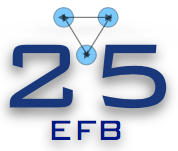Conveners
Tuesday Parallel Session: Reactions (AudiMax)
- Stanisław Kistryn
The optical potential is a well-known and successful framework to describe nucleon-nucleus scattering processes. Within this approach it is possible to compute the scattering observables for elastic processes across wide regions of the nuclear landscape and extend its usage to inelastic processes and other types of reactions such as nucleon transfer, capture or breakup. A phenomenological...
We applied a many-configurational microscopic cluster model to study the nature of high-energy resonance states in $^{9}$Be and $^{9}$B near $^{7}$Li$+d$ and $^{7}$Be$+d$ decay thresholds and to reveal the influence of the states on the astrophysical $S$-factors of the reactions $^{7}$Li$\left( d,n\right)\alpha\alpha$ and $^{7}$Be$\left( d,p\right) \alpha\alpha$ related to the cosmological...
The three-nucleon force (3NF) is essentially important to clarify various nuclear phenomena, such as the binding energy of light mass nuclei [1], the equation of state of nuclear matter [2] and few-nucleon scattering systems [3]. The isospin $T=3/2$ components of the 3NF also play an important role in many-nucleon systems especially for neutron-rich nuclei as well as neutron matter...
We present a comprehensive theoretical study of low-energy few nucleon scattering for systems with A≤4. To this end, we utilize pionless effective field theory, which we employ at next-to-leading order. Our results indicate that the theory provides accurate predictions for the low-energy scattering parameters in all studied channels. These predictions match the best experimental evaluations...
We would like to show one more fruitful application of the clothed-particle notion in the theory of electromagnetic interactions with nuclei. A constructing element of our consideration is the Campbell–Hausdorff expansion formula applied to the initial Noether current density operator
$\phantom{Eq. (1)} J^{\mu}(0) = e^R J^{\mu}_{c}(0)...

